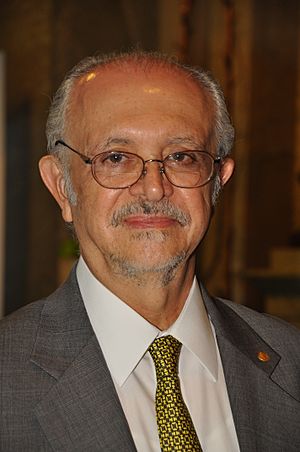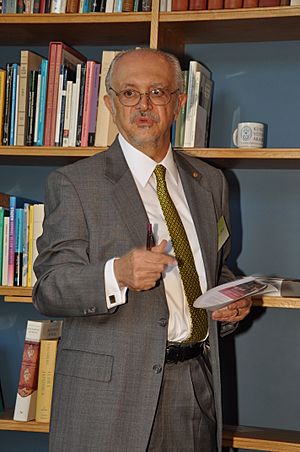Mario Molina facts for kids
Quick facts for kids
Mario Molina
|
|
|---|---|

Molina in 2011
|
|
| Born |
Mario José Molina Henríquez
19 March 1943 Mexico City, Mexico
|
| Died | 7 October 2020 (aged 77) Mexico City, Mexico
|
| Education |
|
| Spouse(s) |
|
| Awards |
|
| Scientific career | |
| Fields | Chemistry |
| Institutions | |
| Thesis | Vibrational Populations Through Chemical Laser Studies: Theoretical and Experimental Extensions of the Equal-gain Technique (1972) |
| Doctoral advisor | George C. Pimentel |
| Doctoral students | Renyi Zhang |
Mario José Molina Henríquez (born March 19, 1943 – died October 7, 2020) was a famous Mexican chemist. He helped discover the Antarctic ozone hole. In 1995, he won the Nobel Prize in Chemistry. He received this award for finding out that certain gases, called chlorofluorocarbons (CFCs), were harming Earth's ozone layer.
Molina was the first scientist born in Mexico to win a Nobel Prize in Chemistry. He was also the third Mexican-born person to receive any Nobel award. During his career, Molina worked at many top universities. These included the University of California, Irvine, California Institute of Technology, and Massachusetts Institute of Technology. He also directed the Mario Molina Center in Mexico City. This center focuses on energy and the environment.
Mario Molina also advised the President of Mexico, Enrique Peña Nieto, on climate policy. On October 7, 2020, the National Autonomous University of Mexico announced that Molina had passed away from a heart attack.
Contents
Early Life and Education
Mario Molina was born in Mexico City on March 19, 1943. His parents were Roberto Molina Pasquel and Leonor Henríquez. His father was a lawyer and a diplomat. He served as an ambassador for Mexico in several countries. His mother managed the family home.
From a young age, Mario was very interested in chemistry. He even turned a bathroom in his home into his own small lab. He used toy microscopes and chemistry sets for experiments. His aunt, Ester Molina, was a chemist herself. She helped him with more difficult chemistry projects.
Mario knew he wanted to be a chemist. When he was 11, he went to a boarding school in Switzerland. There, he learned to speak German. He had first wanted to be a professional violinist. But his love for chemistry became stronger.
Molina started his university studies at the National Autonomous University of Mexico. He earned his bachelor's degree in chemical engineering in 1965. After that, he studied in Germany for two years. He then went to the University of California, Berkeley for his advanced studies. He earned his PhD there. Later, he returned to Mexico to start the first chemical engineering program at his old university.
Career Highlights and Research
Mario Molina began his research at the University of California, Berkeley in 1968. He earned his PhD in physical chemistry there. At Berkeley, he worked on projects studying how molecules move. He also looked at how energy is shared in chemical reactions. His professor, George C. Pimentel, helped him love chemistry even more.
After getting his PhD in 1973, Molina joined a research program with F. Sherwood Rowland. They started studying chemicals called Chlorofluorocarbons (CFCs). These two scientists would soon make a huge discovery about Earth's atmosphere. They developed a theory about how CFCs were destroying the ozone layer. This discovery made people around the world realize they needed to reduce CFC use.
From 1974 to 2004, Molina worked at several important research places. These included the University of California, Irvine, the Jet Propulsion Laboratory, and the Massachusetts Institute of Technology (MIT). In 2004, he joined the University of California, San Diego. He also worked at the Center for Atmospheric Sciences.
In 2005, Molina started a non-profit organization in Mexico City. It was called the Mario Molina Center for Strategic Studies in Energy and the Environment. He served as its director. This center works on important environmental issues.
Molina also advised the Pontifical Academy of Sciences. He helped write a report in 2017 about fighting climate change. This report suggested 12 ways to protect people and the planet.
In 2008, U.S. President Barack Obama asked Molina to join a team on environmental issues. He was also a member of the President’s Council of Advisors on Science and Technology.
In 2020, Mario Molina also contributed to research about wearing face masks. This research showed how important masks were during the SARS-COV-2 pandemic. It was published in a major science journal.
Discovery of Harmful Effects of CFCs
In 1973, Mario Molina joined Professor F. Sherwood Rowland's lab. Molina continued Rowland's research on "hot atom" chemistry. This is the study of atoms with extra energy from radioactive processes.
This work soon led them to study chlorofluorocarbons (CFCs). CFCs were gases used in refrigerators, spray cans, and plastic foams. People thought they were harmless. But Molina wondered what would happen when these new chemicals were released into the environment.
Molina and Rowland had studied similar compounds before. They used their knowledge of chemistry and computer models. They figured out how CFCs could harm the ozone layer. They realized that CFCs released into the air would rise higher and higher. In the highest parts of the atmosphere, called the stratosphere, conditions are different.
The stratosphere has a thin layer of ozone. This ozone layer protects Earth from the sun's harmful ultraviolet (UV) light. Molina thought that UV light, which breaks down oxygen, could also break down CFCs. This would release chlorine atoms into the stratosphere.
Chlorine atoms (Cl) are very reactive. They have an unpaired electron. These chlorine atoms react easily with ozone molecules (O3). When they react, they take one oxygen atom from ozone. This leaves O2 (oxygen gas) and chlorine monoxide (ClO).
- Cl· + O3 → ClO· + O2
Chlorine monoxide (ClO) is also very reactive. It then reacts with another ozone molecule. This releases more O2 and a chlorine atom.
- ClO· + O· → Cl· + O2
The important thing is that the chlorine atom is not used up in these reactions. It stays in the system. This means one chlorine atom can destroy many ozone molecules.
Molina and Rowland predicted that chlorine atoms from CFCs would act like a catalyst. They would keep destroying ozone. When they calculated how much ozone could be destroyed, they realized CFCs could cause serious damage.
In 1974, Molina and Rowland published their findings in the journal Nature. They warned about the threat of CFCs to the ozone layer. At that time, CFCs were widely used. They also wrote a longer report and called for a ban on CFCs.
Many companies and chemical groups disagreed with their findings at first. But in 1976, the National Academy of Sciences supported their work. More proof came in 1985 when Joseph C. Farman found a large hole in the ozone layer over Antarctica.
This led to the Montreal Protocol in 1987. Fifty-six countries signed this agreement to reduce CFC production. Later, CFCs were almost completely removed from spray cans and refrigerators worldwide. This agreement helped slow down ozone depletion and even climate change.
For this important work, Molina shared the Nobel Prize in Chemistry in 1995. He shared it with Paul J. Crutzen and F. Sherwood Rowland. They were recognized for their work in atmospheric chemistry and understanding ozone.
After the ozone hole was found in Antarctica, Mario Molina led a team to study it. They found that the conditions in Antarctica's stratosphere were perfect for chlorine to destroy ozone quickly.
Awards and Recognition
Mario Molina received many awards and honors. The most famous was the 1995 Nobel Prize in Chemistry.
He was elected to the United States National Academy of Sciences in 1993. He also became a member of the Institute of Medicine in 1996. In Mexico, he joined The National College of Mexico in 2003.
Molina won the 1987 Esselen Award and the 1988 Newcomb Cleveland Prize. He also received the 1989 NASA Medal for Exceptional Scientific Advancement. In 1990, he received a $150,000 grant for his environmental work.
In 1996, he received the Golden Plate Award. He also won the 1998 Willard Gibbs Award. An Asteroid (number 9680) was named 9680 Molina in his honor.
On August 8, 2013, U.S. President Barack Obama gave Molina the Presidential Medal of Freedom. This is one of the highest civilian awards in the United States. President Obama said Molina was a "visionary chemist and environmental scientist."
Molina also received the Lifetime Achievement Award in 2014.
Honorary Degrees
Mario Molina received over thirty honorary degrees from universities around the world. These included:
- Yale University (1997)
- Tufts University (2003)
- Duke University (2009)
- Harvard University (2012)
- Many universities in Mexico, the U.S., Canada, and Europe.
Personal Life
Mario Molina married fellow chemist Luisa Y. Tan in July 1973. They had met while he was studying at the University of California, Berkeley. They moved to Irvine, California that year. They had a son, Felipe Jose Molina, in 1977. Mario and Luisa divorced in 2005. Luisa Tan Molina is now a lead scientist at the Molina Center in La Jolla, California. Mario Molina married his second wife, Guadalupe Álvarez, in February 2006.
Molina passed away on October 7, 2020, at the age of 77. He died from a heart attack.
Works
- Molina, Luisa T., Molina, Mario J. and Renyi Zhang. "Laboratory Investigation of Organic Aerosol Formation from Aromatic Hydrocarbons", Massachusetts Institute of Technology (MIT), United States Department of Energy, (August 2006).
- Molina, Luisa T., Molina, Mario J., et al. "Characterization of Fine Particulate Matter (PM) and Secondary PM Precursor Gases in the Mexico City Metropolitan Area", Massachusetts Institute of Technology (MIT), United States Department of Energy, (October 2008).
See also
 In Spanish: Mario Molina (químico) para niños
In Spanish: Mario Molina (químico) para niños


